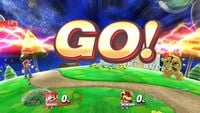Genre
Genres are different types of video games classified by gameplay. With over 250 entries, the Mario franchise has included a variety of different genres. The oldest Mario games started out as platformers, but with the introduction of the Super Nintendo Entertainment System and Nintendo 64, many new genres of Mario games were created.
- See also: List of games by genre
Types of Genres
Platform

Platform games (often known as platformers) consist of going through levels to reach a goal. The majority of Mario games fit under this category. This genre can be divided into two sub-genres: sidescrollers and three-dimensional platformers. Sidescrollers are the most common type of platform game and usually allow travel in only one or two directions. Three-dimensional platformers allow travel in any direction and usually consist of the newer Mario platform games. A sidescroller may have three-dimensional graphics, like New Super Mario Bros. Wii, but it is still classified as a sidescroller.
The 3D platformers have a feature that brings up a menu of what Power Star (or Shine Sprite in the case of Super Mario Sunshine and Power Moon in the case of Super Mario Odyssey) to get whenever Mario enters an area (except Super Mario 3D Land and Super Mario 3D World, where levels are instead completed by reaching the Goal Pole). The player can select a star they have gotten once before, and fight any of the bosses as many times as they want.
Most Mario platformers are part of the Super Mario series. An exception is Super Paper Mario, which is the only platformer from the Paper Mario series, being a mixture of platformer and RPG genres.
For the list of platform games, see Category:Platforming Games.
Role-playing
Role-playing games (often abbreviated as RPGs) place Mario in a major role. Common gameplay features in RPGs include detailed storylines, a large cast of characters and the ability to level up. Mario's first appearance in an RPG was in Super Mario RPG: Legend of the Seven Stars. Later, the Paper Mario series and Mario & Luigi series were introduced. Another common feature in RPGs is the ability to use items and equip weapons, armor, clothing, badges, and accessories. These items can be bought at shops or be found in blocks and treasure chests. RPGs often have multiple playable characters with unique stats and abilities. Mario role-playing games often contain platforming elements.
The battle system usually involves Mario, his partner(s), and enemies taking it in turns to attack, with action commands to every move. The Paper Mario series differs slightly from the other RPGs because the damage and HP ratio is lower and Mario and his partner always attacks first, and attack power is achieved by getting hammers and boots rather than leveling up. Paper Mario is also split into chapters for which stars Mario must get, and has chapter bosses, with minibosses along the way, while neither really exists in the other RPGs; only bosses, identifiable by different battle theme and higher HP (and often they are characters). Super Mario RPG: Legend of the Seven Stars and Paper Mario: The Thousand-Year Door make it possible to completely defend against attacks (excluding magic attacks in Super Mario RPG), or at least reduce the amount of damage taken. In the Mario & Luigi series it is possible (and often necessary) to avoid enemy attacks altogether. The Mario & Luigi series also introduces the new special moves to Mario and Luigi called Bros. Attacks, Bros. Items, Special Attacks, Luiginary Attacks. and Trio Attacks. These moves all use BP or SP, though the latter series also differs from the most role-playing games because of the focus on controlling both Mario and Luigi simultaneously with Luigi following Mario's movement.
RPGs also feature normal Mario enemies including Goombas, Koopa Troopas, and other common enemies. However, characters and locations originally found in an RPG rarely appear in other games.
Various other games have RPG elements fused into them, but are not traditional RPGs in the sense the aforementioned series are, such as some of the handheld Mario Tennis and Mario Golf games; namely Mario Tennis and Mario Golf for the Game Boy Color, Mario Tennis: Power Tour and Mario Golf: Advance Tour for the Game Boy Advance, and Mario Golf: World Tour for the Nintendo 3DS. In these games, they fuse their respective sport with RPG-like mechanics. Another example is Puzzle & Dragons: Super Mario Bros. Edition, where the game is a puzzle game with a heavy emphasis on RPG elements.
For the list of role-playing games, see Category:RPGs.
Party
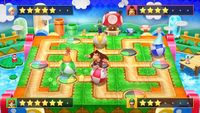
Party games are multiplayer games usually involving short minigames. This genre is dominated by the Mario Party series, but the WarioWare series and Itadaki Street DS are also part of it. While most party games involve multiple players, some party games are single player, like certain WarioWare games. Luck is a large factor in party games, but players must also have a certain degree of skill. Party games are rarely played competitively and are usually played casually, although many also have story modes that can be completed.
Racing
Racing games involve speedy competitions with other characters. The main objective in racing games is to reach the finish line before the other racers and attain first place. Nearly all Mario racing games are part of the Mario Kart series, except for Diddy Kong Racing, Diddy Kong Racing DS, and Donkey Kong Barrel Blast. All racing games in the Mario series involve items or power-ups which can do various things like slow down the other racers or speed up the player. Racing games also build on this by providing battle modes in which items are used as weapons. Online racing was introduced with the release of Mario Kart DS and is integrated in every Mario racing game since.
For the list of racing games, see Category:Racing Games.
Sports
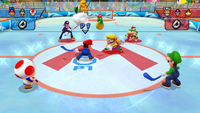
Sports games, like the name implies, are games based on sports. Unlike most conventional sports games, Mario sports games feature items and obstacles. Racing and fighting games are sub-genres of sports games. The genre started with Golf for the Nintendo Entertainment System. This genre of Mario games did not become well known until the release of the Nintendo 64 with games like Mario Tennis 64 and Mario Golf for the Nintendo 64. Currently, Mario sports games include golf, racing, tennis, soccer, basketball, fighting, baseball, and Olympic events. In addition, separately from those series are the games Mario Sports Mix and Mario Sports Superstars, which feature four and five sports respectively.
For the list of sports games, see Category:Sports Games.
Puzzle

Puzzle games test the player's reflexes and knowledge. The objective in most Mario puzzle games is to clear the screen of various objects similar to Tetris. However, a few Mario puzzle games incorporate different types of gameplay such as Mario's Picross and mahjong. Games belonging to this genre include the Dr. Mario series, Wario's Woods, Yoshi's Cookie, and Puzzle & Dragons: Super Mario Bros. Edition. Other than the latter, unlike most Mario games, puzzle games do not have items. However, they generally have a large cast of characters.
For the list of puzzle games, see Category:Puzzle Games.
Fighting
Fighting games pit characters against each other in combat. The objective of most fighting games is to knock out the other characters. Fighting games are a sub-genre of sports games. This genre has exclusively been a part of the crossover Super Smash Bros. series.
Mario's first appearance in a fighting game was as a referee in Punch-Out!! (the latest installation in that series features Donkey Kong as an opponent). Mario's first playable role in a fighting game was in Super Smash Bros., along with Luigi, Yoshi, and Donkey Kong. Fighting games in the Mario franchise have significant differences from arcade fighting games. Bowser, Princess Peach, and Dr. Mario later appeared in Super Smash Bros. Melee, and Wario and Diddy Kong appeared alongside all of them (except Dr. Mario) in Super Smash Bros. Brawl, and Rosalina and Bowser Jr. made an appearance in Super Smash Bros. for Nintendo 3DS / Wii U and Princess Daisy, Peachś Echo Fighter and Piranha Plant make their appearance as a newcomer in ´´Super Smash Bros. Ultimate´´. Instead of depleting the enemy's health, the player must knock the enemy off the screen. Items and obstacles are also available whereas most fighting games do not have them.
Edutainment
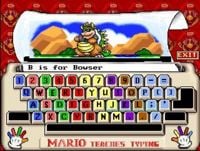
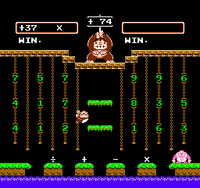
Edutainment games are meant to both educate and entertain the player. Compared to the other genres in the Mario franchise, the number of edutainment games is relatively small. The purpose of edutainment games is to solve mysteries or simply learn how to do something, like typing or math. Games belonging to this genre are usually developed by a third party company. Due to this, characters may have different personalities. For example, Mario has full dialogue in Mario's Time Machine, despite the fact that he rarely speaks in other games.
For the list of edutainment games, see Category:Edutainment Games.
Dancing
Dancing games are games where the player must step on the arrows of a dance mat according to in-game instructions. There are only two Mario dancing games: Mario Undoukai and Dance Dance Revolution: Mario Mix, based on the Dance Dance Revolution series.
Rail shooter
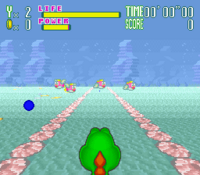
Rail shooter games are games where the game follows a specific route and that the player must shoot all the enemies on the screen. The only Mario rail shooter game to date is Yoshi's Safari. To play it in single player, the player must use the Super Scope.
Turn-based tactics
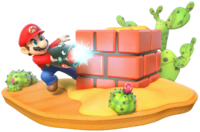
These games involve turn-based gameplay (similar to an RPG) in a warfare-like scenario, involving the player tactfully positioning their characters to attack and defend against enemies. Mario + Rabbids Kingdom Battle is the only game in the Mario franchise of this genre.


